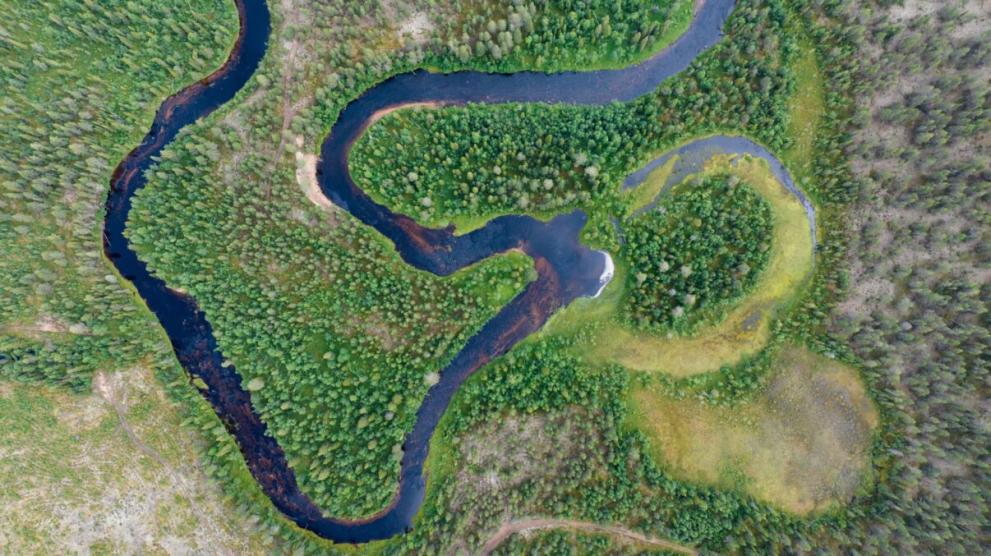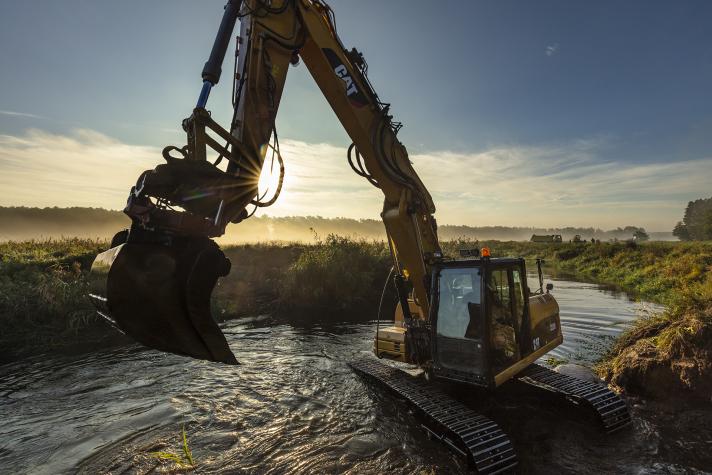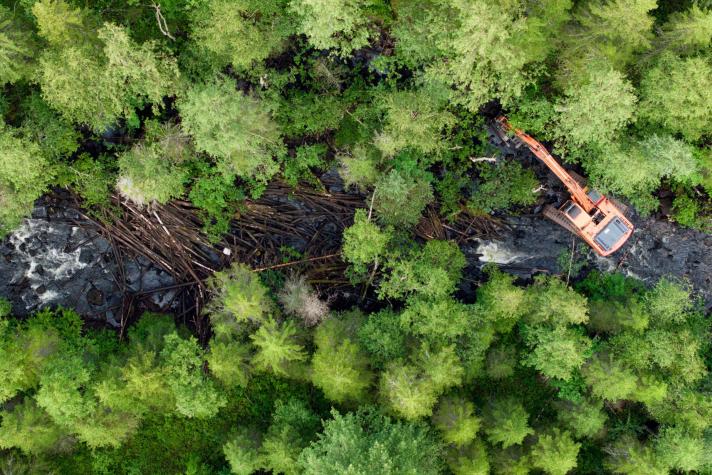
What is Rewilding Europe's mission?
Rewilding Europe's mission is restoring nature at a large scale and making Europe a wilder place. It's about giving nature space to take care of itself. We focus on restoring the functioning of healthy ecosystems, such as repairing broken water cycles of our river systems across Europe, and all the traffic chains and functions associated with that.
Why is rewilding so important?
From a water perspective, rewilding is important because it restores the machine that allows us to live. Without functional water systems, people won’t have access to the quantities and quality of water we need.
Restoring the hydrological regime is key, which involves giving our freshwater systems the space and time to recover from over-exploitation, pollution and various threats. When we allow these systems to heal, they will, in turn, give us what we need to survive. Water should be a top priority for humanity, yet it is often undervalued. Terrestrial ecosystems and their transformation are often the only focus, while freshwater and rivers are forgotten, with investment being much lower.
Why does Rewilding Europe restore water systems and natural waterways?
Our goal is to create well-connected and free-flowing rivers, with functioning hydrological regimes. This means maintaining the natural water cycle of flooding, evaporation, and precipitation. For these regimes to work naturally without human interference, we aim to restore the natural riparian vegetation - plants and trees along riverbanks and water margins - essential for erosion control and the natural flow and speed of river water.
Restoring waterways plays a significant role in climate change mitigation. Healthy rivers and wetlands can safeguard us from extreme weather events by reducing the risk of floods. Natural transport of sediment along the rivers is also crucial for agricultural lands downstream and for the nutrition of those lands.
We want rivers to retain their natural structure, without artificial channeling, so they can meander, expand and contract within their natural flooding regime. Giving space to rivers to follow their natural course is one of our key actions. Both lateral and longitudinal connectivity are vital for rivers to flow naturally to the sea. Restoring these connections allows migratory fish to thrive and provides numerous other ecological benefits. By reconnecting rivers to their natural landscapes, we enhance their overall health and functionality.
Will restoring rivers help against climate change and flooding?
Flooding is a natural occurrence in the river. If a river doesn't flood and pulse, it's essentially dead. For a river to flood in a healthy way that benefits both nature and people, it needs space.
The problem is that rivers don't have that space anymore. When they do flood, which is a natural event, they flood in ways and in areas that severely impact people, because we took away that space from them.
This has led to viewing rivers and flooding as enemies. They are not. Flooding is natural and vital for agriculture, distributing nutrients across the land and creating fertile valleys. Without natural flowing, we lose these nutrients and have to rely on chemicals and fertilizers.
By restoring rivers, they can flood laterally, reducing flow speeds and creating breeding grounds for fish, birds, mammals and all sorts of other species.
Flooding has become more extreme, partly because of climate change, but mainly because we are not coexisting with our rivers in a way that accommodates these changes. To protect ourselves from the extremes of climate change, we need to work with rivers and freshwater systems to ensure they help provide this protection.
Tell us about your Danube Delta and Oder Delta projects.
Rewilding the Danube Delta
The Danube Delta rewilding landscape is a flagship program for us. In the lower delta, many dams and dikes have restricted water flow and flooding of floodplains, which are essential for creating fertile grounds. Our colleagues have already removed at least 10 dams and continue to remove dikes to restore the natural connectivity.
When you think of a lowland river, it's important to think beyond just the water and include the entire floodplain ecosystem. Restoring the connectivity and natural process of flooding is at the heart of our work, ensuring that these rivers can support healthy, fertile environments once again.
To have a healthy floodplain, you need water, at the right amount, at the right time of the year, at the right speed. But you also need a community of animals that can stimulate natural vegetation growth.
We are planning to introduce wild horses and water buffalo to bring natural grazing functions to the floodplains. These animals, through their movement and trampling, regulate vegetation growth and help create diverse floodplains and wetlands. Water buffalo, in particular, open up the floodplains and create micro-habitats for fish, birds and all sorts of other animals.
Rewilding the Oder Delta
In the Oder Delta, our efforts focus on the removal of dams. We mapped catchments and identified obsolete dams for removal. This work is also being carried out in Portugal, Sweden, Italy and Romania, where we locate and evaluate obsolete dams for potential removal.
The Oder Delta is a complex system with many stakeholders. Our team is working closely with farmers to restore flooded areas in these lowlands, including peatlands, which are crucial for climate change mitigation. We are also addressing environmental impact and compensation mechanisms associated with peat restoration. By engaging with companies, we ensure they comply with their environmental management plans and compensate for any unavoidable damage.
Why is restoring these waterways so vital?
When you restore a wetland, lots of functions come back.
Filtration improves, and functioning floodplains lead to immediate improvements in water quality and erosion control. This benefits nature, as entire ecosystems depend on good water quality. Without it, fisheries and everything associated with it will decline.
By restoring flooding of peatlands, we expect an increase in water retention in these systems, which will likely reduce drought. In coastal lands, we also expect less intrusion of salt from the sea. The intrusion of seawater in the delta can be highly destructive and very difficult to reverse.
Could you tell me about other water-related rewilding projects at Rewilding Europe?
River and Freshwater Restoration
It's crucial to bolster on-the-ground efforts for freshwater issues, particularly since conservation efforts tend to favour terrestrial systems. We are restoring longitudinal river connectivity by removing dams and outdated structures. This year, we're focusing on nine dam removals in Sweden and Italy, with plans for an additional 11 by 2025, including in Portugal.
In Scotland, we are focusing on riverine work. Scotland is completely depleted of forests, which are key for good, healthy river systems. We are working with local partners to restore the riverine forests along river systems to mitigate the impacts of climate change. As temperatures rise, so does water temperature, which is detrimental to fish species. By bringing back riverine forests, we create shaded areas along rivers, which will improve conditions for fish to breed in high mountain systems.
Restoring Romanian Rivers
In the Southern Carpathians of Romania, we're prioritizing the removal of dams throughout entire catchments to safeguard vital mountain landscapes that are depending on healthy river systems.
Swedish rivers
In Sweden, we're restoring lateral connectivity of the River Abramsån by rehabilitating sections that were historically obstructed. Large stones were once removed from the middle of rivers to create pathways for transporting wood downstream. Our current efforts involve bringing back large boulders, and restoring natural river structures to enhance flow and support vital ecosystems, such as flooded forests and adjacent peatlands.
Keystone species reintroduction
Our rewilding efforts also focus on the reintroduction of freshwater-dependent keystone species like beavers, which play a crucial role in an ecosystem. We prioritize reintroducing species that are essential for ecosystem health, rather than focusing solely on rare species. In the Danube region, we're reintroducing sturgeons, crayfish and trout, while also supporting the comeback of the Dalmatian pelicans to support freshwater trophic chains.
How important are partnerships for achieving a water resilient Europe?
Collaboration is at the heart of our work. We work closely with municipalities in Italy, councils in Sweden, and government entities in Portugal to advance our rewilding goals. In Sweden, we've also partnered with an angling sport fishing association to facilitate dam removals. Our innovative refundable grant model supported this NGO to cover upfront costs of dam removals, which are reimbursed once the government pays. This approach ensures that funds continue to support ongoing restoration efforts.
What advice would you give to promote natural solutions for water resilience?
Convincing people of the importance of rewilding can be challenging. The key is to show our deep connection with nature and our dependence on it, particularly on water and freshwater systems. Freshwater systems are not just sources of water. They are part of a complex system that includes wildlife underwater and above. It is crucial to recognize that we are part of this interconnected system.
Sometimes, we forget that we can’t live without water.
For more information
Details
- Publication date
- 24 July 2024
- Author
- Directorate-General for Environment



